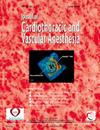招募-充气比和肺顺应性对评估心脏手术患者肺部招募能力的有用性:一项前瞻性研究。
IF 2.1
4区 医学
Q2 ANESTHESIOLOGY
Journal of cardiothoracic and vascular anesthesia
Pub Date : 2025-08-10
DOI:10.1053/j.jvca.2025.08.014
引用次数: 0
摘要
目的:通过收集肺顺应性值和计算肺泡恢复与充气(R/I)比,评估心脏手术患者在围手术期3个时间点(插管后、体外循环(CPB)后和到达重症监护病房(ICU)时肺泡恢复的可能性。设计:一项在麻醉和重症监护室进行的介入队列单中心研究:这项介入研究对41例接受非复杂心脏手术的患者进行了研究。在肺复吸操作(LRM)之前、期间和之后(呼气末正压[PEEP] 12 cmH2O时3分钟)测量通气力学、血气分析和血流动力学参数。回顾性计算3个时间点的R/I比率。参与者:该研究包括预定进行选择性,非紧急心脏手术需要体外循环(CPB)的患者,包括冠状动脉旁路移植术(CABG),瓣膜置换术和瓣膜修复术。干预措施:R/I比值测量。测量结果和主要结果:随着时间的推移,可招募患者(R/I >0.5)的比例从插管后(IOT)的61%(25例)下降到cpb后(12例)的29%(12例)和ICU的17%(7例)。招募后,可招募患者在所有3个时间点的肺顺应性均显著高于不可招募患者(R/I平均动脉压下降20%)。结论:在这项研究中,R/I比值为0.5,确定了高达60%的患者具有潜在的可招募性。考虑到PaO2、动脉血氧分压(PaO2)、PaO2:吸入氧比分数和招募前依从性并不能预测积极的招募反应,该参数尤其有价值。需要进一步的研究来评估R/I比值在个性化PEEP设置和减少心脏手术患者肺部并发症方面的效用。本文章由计算机程序翻译,如有差异,请以英文原文为准。
Usefulness of the Recruitment-to-Inflation Ratio and Pulmonary Compliance for Assessing Pulmonary Recruitability in Cardiac Surgery Patients: A Prospective Study
Objective
To evaluate in cardiac surgery patients the potential for alveolar recruitment at 3 perioperative time points—after intubation, after cardiopulmonary bypass (CPB), and on arrival in the intensive care unit (ICU)—by collecting pulmonary compliance values and calculating the recruitment-to-inflation (R/I) ratio.
Design
An interventional cohort single-center study conducted in a department of anaesthesiology and critical care and an ICU
Setting
This interventional study was conducted in 41 patients undergoing noncomplex cardiac surgery. Ventilatory mechanics, blood gas analysis, and hemodynamic parameters were measured before, during, and after a lung recruitment maneuver (LRM) (3 minutes at a positive end-expiratory pressure [PEEP] of 12 cmH2O). The R/I ratio was calculated retrospectively at 3 time points.
Participants
The study included patients scheduled for elective, nonurgent cardiac surgery requiring cardiopulmonary bypass (CPB), including coronary artery bypass grafting (CABG), valve replacement, and valve repair.
Interventions
R/I ratio measurement.
Measurements and Main Results
The proportion of recruitable patients (those with an R/I >0.5) decreased over time, from 61% (25 patients) postintubation (IOT), to 29% (12 patients) post-CPB and 17% (7 patients) in the ICU. After recruitment, lung compliance at all 3 time points was significantly higher in recruitable patients (R/I >0.5) compared to nonrecruitable patients (R/I <0.5) (p < 0.01). At all 3 time points, compliance before LRM did not differ significantly between the recruitable and nonrecruitable groups. Of the 123 LRMs performed in 41 patients, 11 (9%) were interrupted because of hemodynamic intolerance (defined as a >20% drop in mean arterial pressure).
Conclusions
In this study, an R/I ratio >0.5 identified up to 60% of patients as potentially recruitable. This parameter is particularly valuable given that PaO2, partial pressure of oxygen in arterial blood (PaO2), PaO2:fraction of inspired oxygen ratio, and prerecruitment compliance did not predict a positive recruitment response. Further studies are needed to assess the utility of the R/I ratio in individualizing PEEP settings and reducing pulmonary complications in cardiac surgery patients.
求助全文
通过发布文献求助,成功后即可免费获取论文全文。
去求助
来源期刊
CiteScore
4.80
自引率
17.90%
发文量
606
审稿时长
37 days
期刊介绍:
The Journal of Cardiothoracic and Vascular Anesthesia is primarily aimed at anesthesiologists who deal with patients undergoing cardiac, thoracic or vascular surgical procedures. JCVA features a multidisciplinary approach, with contributions from cardiac, vascular and thoracic surgeons, cardiologists, and other related specialists. Emphasis is placed on rapid publication of clinically relevant material.

 求助内容:
求助内容: 应助结果提醒方式:
应助结果提醒方式:


